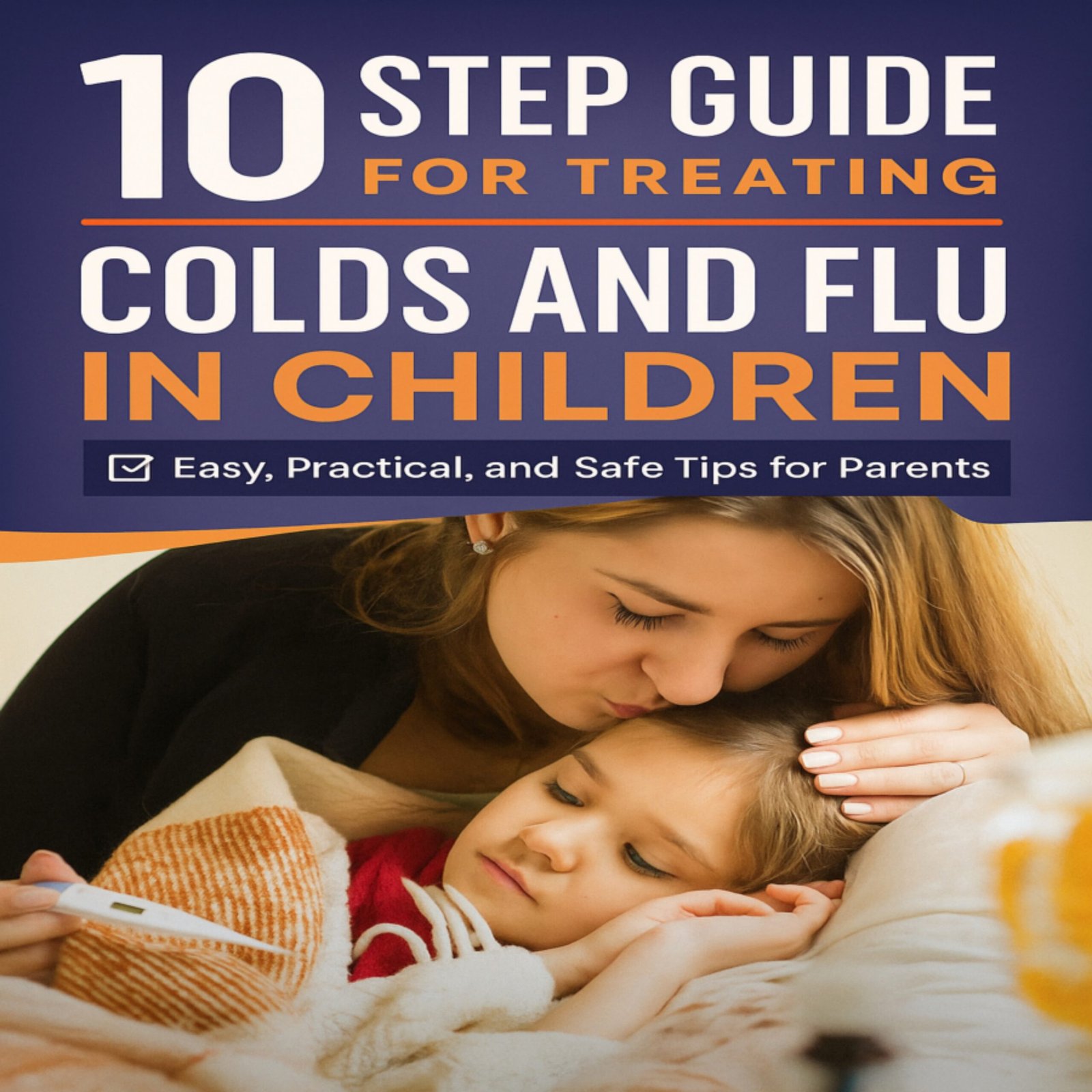10-Step Guide for Treating Colds and Flu in Children: A Practical Step-by-Step Guide for Parents
Original price was: $11.99.$9.99Current price is: $9.99.
Description
10-Step Guide for Treating Colds and Flu in Children: A Practical Step-by-Step Guide for Parents
Simple, Safe, and Effective Home Care Tips for Your Child’s Health
Book Description
Help your child recover from colds and flu with confidence and peace of mind.
This easy-to-follow 10-Step Guide gives parents clear, practical instructions for managing symptoms at home, reducing fever safely, keeping kids comfortable, and knowing when to call the doctor. Inside, you’ll find:
-
Step-by-step guidance for the first signs of illness
-
Safe ways to relieve symptoms naturally
-
Nutrition tips and hydration strategies
-
Red flag warnings for serious symptoms
-
Prevention advice for long-term health
Written in a friendly and professional tone, this guide is designed to be a quick, reliable reference every parent can trust.
Give your child the care they need while staying calm and informed every step of the way.
-
child cold and flu home care
-
parenting health guide for children
-
fever treatment for kids at home
-
natural remedies for child illness
-
practical health tips for parents
-
child illness prevention and care
-
when to call doctor for sick child
-
Health & Fitness > Children’s Health
-
Family & Relationships > Parenting > Health
-
Medical > Home Care
10 Step Guide for
Treating Colds and
Flu in Children
A Practical Step-by-Step Guide for Parents
Stay Calm and
Assess the Situation
When your child shows symptoms like fever or
cough, the most important thing is to stay calm
and avoid panicking. Children often mirror the
emotions of their parents, so your anxiety can
make them feel worse and complicate the
situation. Take a moment to observe their overall
behavior — are they alert and responsive or
unusually quiet and tired? Check energy levels,
hydration, appetite, and any additional symptoms
such as rash, breathing difficulties, or signs of
dehydration like dry lips or absence of tears
when crying. Make sure the environment is
comfortable, with appropriate clothing and room
temperature, and start keeping a simple
symptom diary to record temperature readings,
time of onset, and any changes you notice.
Staying calm allows you to think clearly, make
better decisions, and provide reassurance to your
child while preparing the basic supplies you might
need, such as a thermometer, fluids, light
blankets, and age-appropriate medication if
recommended by a doctor.
r.
Take the Temperature
Accurately
Taking your child’s temperature accurately
is essential for understanding the
seriousness of the situation and deciding
on the next steps. Always use a reliable
digital thermometer and follow the
manufacturer’s instructions to ensure
correct readings. For infants and young
children, rectal thermometers provide the
most accurate results, while for older
children, oral or ear thermometers are
usually appropriate. Avoid using old
mercury thermometers, as they can be
dangerous if broken. Record the
temperature, time, and any other
symptoms in a simple health journal so
you can track changes over time or
provide clear information to your
pediatrician if needed. Remember that a
single reading doesn’t tell the whole story
— you want to see how the fever behaves
over several hours. Finally, stay calm and
reassure your child during the process; a
relaxed environment makes it easier to
take accurate measurements and keeps
your child comforta
Ensure Rest and
Comfort
IMaking sure your child gets enough rest
and stays comfortable is one of the
most important parts of helping them
recover from a cold or the flu. Rest
allows the body to focus energy on
fighting the infection, so keep your child
at home, cancel any activities, and create
a calm environment where they can
sleep or relax without distractions.
Ensure the room temperature is
comfortable — not too hot and not too
cold — and dress them in light,
breathable clothing to prevent
overheating. Offer cozy blankets if
needed, but avoid piling on heavy layers
that can trap heat. Sometimes children
want to stay in bed with their favorite
toy, listen to soft music, or watch a calm
cartoon; these little comforts can help
them feel secure and relaxed while they
recover. The goal is to give their body the
chance to heal while keeping their mind
at ease and spirits lifted.
Keep the Child
Hydrated
Keeping your child well-hydrated is
essential when they have a cold or the
flu, as fever, runny nose, or sweating
can quickly lead to fluid loss. Offer
small, frequent sips of water, diluted
fruit juices, or oral rehydration
solutions to prevent dehydration,
especially if your child isn’t eating
much. Warm, soothing liquids like mild
herbal teas or clear broths can be
comforting and help relieve sore
throats and congestion. Avoid sugary
drinks or caffeinated beverages, as
they can worsen dehydration rather
than improve it. Encourage your child
to drink slowly but regularly
throughout the day, even if they only
take a few sips at a time. Signs of
good hydration include moist lips, tears
when crying, and regular bathroom
visits, while dry lips, no tears, and
infrequent urination may signal the
need for more fluids or medical advice.
Manage Fever
Safely
Managing your child’s fever safely is
about lowering discomfort rather than
focusing only on the number on the
thermometer. For mild fevers below
100.4°F (38°C), keeping your child
hydrated, lightly dressed, and in a
comfortable environment is often
enough. If the fever rises above 100.4°F
and your child appears uncomfortable,
you can use age-appropriate fever
reducing medications such as
acetaminophen or ibuprofen, strictly
following the recommended weight
based dosage and instructions provided
by your pediatrician. Never give aspirin to
children because of the risk of Reye’s
syndrome. Avoid cold baths, alcohol rubs,
or overbundling, as these methods can
be harmful. Instead, use lukewarm
sponge baths and light bedding to keep
your child comfortable while monitoring
temperature and symptoms regularly.
Relieve Symptoms
Naturally
Relieving your child’s symptoms
naturally can make them feel much
better while their body fights off the
infection. For nasal congestion, use
saline sprays or drops to keep nasal
passages moist and help clear mucus;
a cool-mist humidifier in their room can
also ease breathing. For a sore throat,
warm fluids like mild herbal teas or
broths can soothe irritation, while older
children can try gentle saltwater
gargles for relief. If coughing keeps
them awake, warm steam from a
shower or bath can help loosen mucus
and reduce throat discomfort. Always
avoid harsh home remedies or over
the-counter cough medicines unless
specifically recommended by your
doctor, as many are not suitable for
young children. These gentle, safe
methods focus on comfort and healing
without introducing unnecessary risks.
Provide Nutritious
Foods
Providing your child with nutritious
foods during a cold or the flu helps
support their immune system and
speeds up recovery. Offer light, easy
to-digest meals such as warm
vegetable soups, broths, and soft
fruits rich in vitamin C like oranges or
kiwis. Yogurt with live cultures can
promote gut health, while whole
grain toast or oatmeal provides
gentle energy. Avoid heavy, greasy, or
overly sugary foods, as they can be
difficult to digest and provide little
nutritional value. If your child has little
appetite, don’t force them to eat —
focus on small, frequent snacks and
plenty of fluids instead. Warm,
comforting meals not only nourish
the body but also provide emotional
comfort when children feel unwell.
Monitor
Progress Closely
Monitoring your child’s progress
closely is essential for knowing
whether they’re improving or if
medical attention is needed. Keep a
simple health journal where you
record temperature readings,
symptoms, medications given, and
any changes in energy levels or
appetite. Check the fever every few
hours, but focus more on how your
child looks and feels rather than just
the thermometer number. Signs of
improvement include reduced fever,
better appetite, increased energy,
and more restful sleep. On the other
hand, if symptoms worsen, new
issues develop, or your child seems
increasingly lethargic, it may be time
to consult a healthcare professional.
Having clear notes helps you give
accurate information to your doctor
and ensures no important detail is
missed.
Know When to Call the
Doctor
Monitoring your child’s progress
closely is essential for knowing
whether they’re improving or if
medical attention is needed. Keep a
simple health journal where you
record temperature readings,
symptoms, medications given, and
any changes in energy levels or
appetite. Check the fever every few
hours, but focus more on how your
child looks and feels rather than just
the thermometer number. Signs of
improvement include reduced fever,
better appetite, increased energy,
and more restful sleep. On the other
hand, if symptoms worsen, new
issues develop, or your child seems
increasingly lethargic, it may be time
to consult a healthcare professional.
Having clear notes helps you give
accurate information to your doctor
and ensures no important detail is
missed.
Prevent Future
Illness
Preventing future illnesses involves
building healthy habits and a strong
immune system for your child. Teach
proper handwashing with soap and
water, especially before eating and
after playing outside, to reduce the
spread of germs. Ensure your child
follows a balanced diet rich in fruits,
vegetables, and whole grains, and
maintains a regular sleep schedule to
support overall health. Encourage
physical activity appropriate for their
age, and keep vaccinations, including
the annual flu shot, up to date as
recommended by your pediatrician.
Avoid exposing your child to
secondhand smoke or crowded
places during peak flu season
whenever possible. These simple but
consistent steps help strengthen
your child’s immunity and reduce the
likelihood of frequent infections.
Resources &
Final Thoughts
As you finish this guide, remember
that caring for a child with a cold or
flu requires a balance of calm
observation, practical home care,
and knowing when to seek
professional help. The steps
provided here are designed to give
you confidence, clarity, and a clear
action plan when your child feels
unwell. For reliable medical
information, consult trusted
organizations such as the
American
Academy of Pediatrics, the
Health Organization, and the
World
Centers
for Disease Control and Prevention.
Keep this guide handy, use it as a
reference during each illness, and
combine it with the advice of your
pediatrician to ensure the best care
for your child’s health and well
being






Reviews
There are no reviews yet.